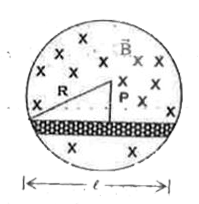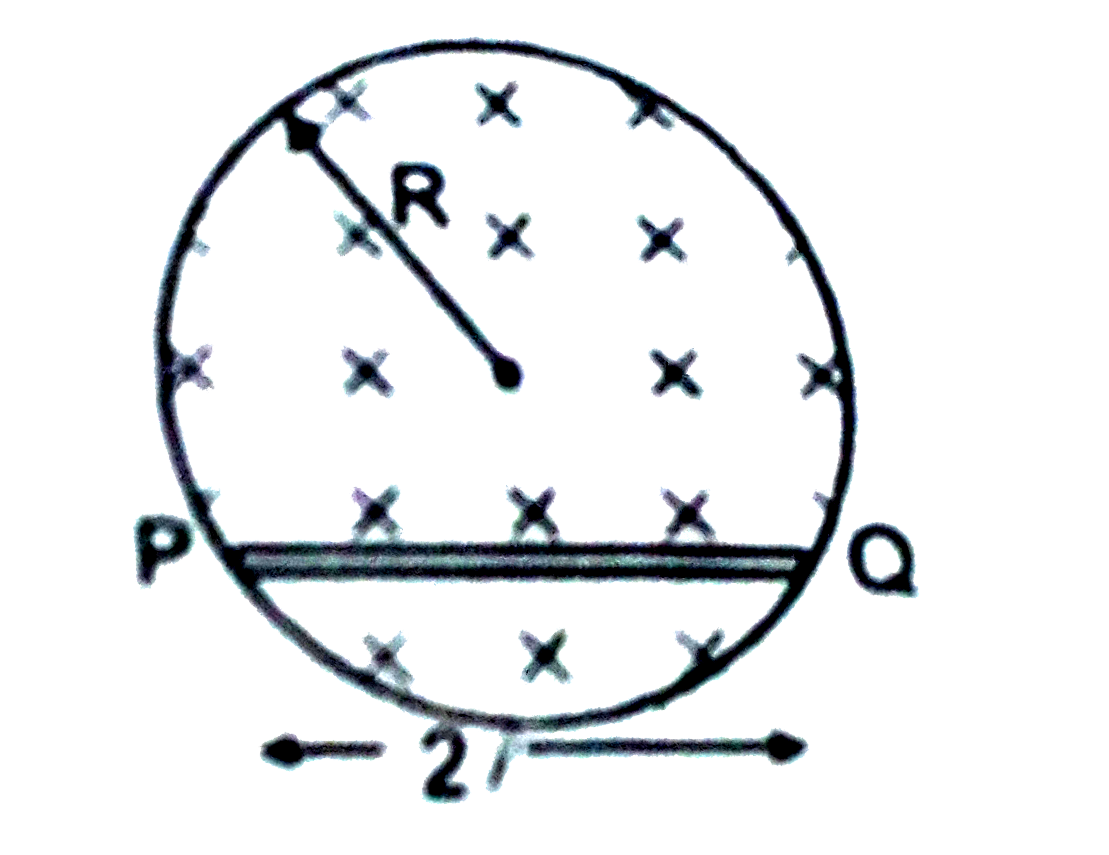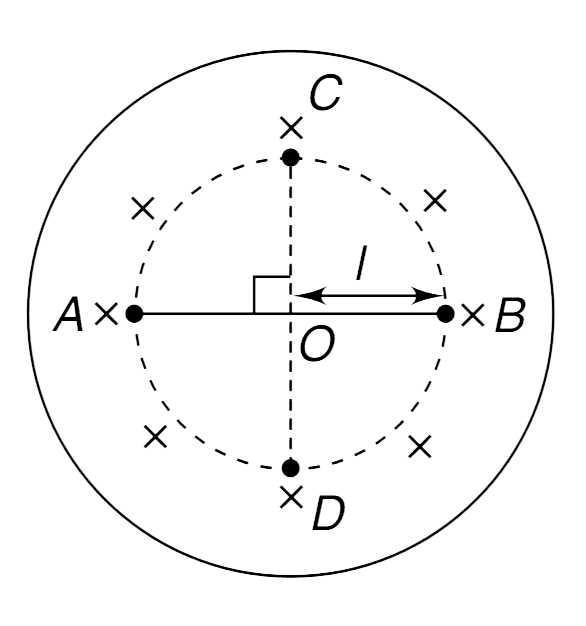a uniform magnetic field of induction fills a cylinderical volume of radius . A rod of length is placed as shown in . If changing at the rate , the emf that is produced by the changing magnetic field and that acts between the ends of the rod is

(a)
(b)
( c)
(d)
The correct Answer is:A
(a) Consider a point on the circumference of a circle of radius . Let be the elctric dield along the tangents to the circle. Then is given by

Now consider a point in the rod and a small distance along .
[ ]
Topper's Solved these Questions
- ELECTROMAGNETIC INDUCTIONBOOK - CENGAGE PHYSICSCHAPTER - ELECTROMAGNETIC INDUCTIONEXERCISE - Exercises Multiple Correct
23 Videos
- ELECTROMAGNETIC INDUCTIONBOOK - CENGAGE PHYSICSCHAPTER - ELECTROMAGNETIC INDUCTIONEXERCISE - Exercises Asserton - Reasoning
8 Videos
- ELECTROMAGNETIC INDUCTIONBOOK - CENGAGE PHYSICSCHAPTER - ELECTROMAGNETIC INDUCTIONEXERCISE - Exercises Subjective
13 Videos
- ELECTROMAGENTIC INDUCTIONBOOK - CENGAGE PHYSICSCHAPTER - ELECTROMAGENTIC INDUCTIONEXERCISE - QUESTION BANK
40 Videos
- ELECTRON,PHONTS,PHOTOELECTRIC EFFECT & X-RAYSBOOK - CENGAGE PHYSICSCHAPTER - ELECTRON,PHONTS,PHOTOELECTRIC EFFECT & X-RAYSEXERCISE - dpp 3.3
15 Videos
Similar Questions
A uniform magnetic field →B fills a cylindrical volumes of radius R. A metal rod CD of length l is placed inside the cylinder along a chord of the circular cross-section as shown in the figure. If the magnitude of magnetic field increases in the direction of field at a constant rate dB/dt, find the magnetitude and direction of the EMF induced in the rod.

View SolutionA glass rod of length l moves with velocity in a uniform magnetic field B. What is the e.m.f. induced in the rod ?
View Solution
Knowledge Check
A uniform magneitc field B fills a cylindrical volume of radius R, A metal rod of length l is placed as shown. If B is changing at the rate of dB/dt, the emf that is produced by the changing magnetic field is ξ here p = √R2−(l2)2. then
 AThe magnitude of the electric field created is 12rdBdtBThe magnitude of the electric field component along the length of the rod is 12pdBdtCThe magnitude of the electric field component perpendicular to the rod is zeroDThe induced emf is 12lpdBdt.
AThe magnitude of the electric field created is 12rdBdtBThe magnitude of the electric field component along the length of the rod is 12pdBdtCThe magnitude of the electric field component perpendicular to the rod is zeroDThe induced emf is 12lpdBdt.A uniform magnetic field of induction B is confined to a cyclindrical region of radius R. The magnetic field is increasing at a constant rate of dB/dt (tesla/ second). A charge q of mass m, placed at the point P on the periphery of the fixed experiences an acceleration :
 A12eRmdBdt towards leftB12eRmdBdt towards rightCeRmdBdt towards leftDzero
A12eRmdBdt towards leftB12eRmdBdt towards rightCeRmdBdt towards leftDzeroA uniform magnetic field, B=B0t (where B0 is a positive constant) , fills a cylinderical volume of radius R, then the potential difference in the conducting rod PQ due to electorstatic field is :
 AB0l√R2+l2BB0l√R2−l24CB0l√R2−l2DB0R√R2−l2
AB0l√R2+l2BB0l√R2−l24CB0l√R2−l2DB0R√R2−l2
A thin rod of copper is being moved in a uniform magnetic field such that it is cutting the magnetic field lines. An emf is induced between the ends of the rod.
View SolutionA massless non conducting rod AB of length 2l is placed in uniform time varying magnetic field confined in a cylindrical region of radius (R>l) as shown in the figure. The center of the rod coincides with the centre of the cylin- drical region. The rod can freely rotate in the plane of the Figure about an axis coinciding with the axis of the cylinder. Two particles, each of mass m and charge q are attached to the ends A and B of the rod. The time varying magnetic field in this cylindrical region is given by B=B0[1−t2] where B0 is a constant. The field is switched on at time t=0. Consider B0=100T,l=4cmqm=4π100C/kg. Calculate the time in which the rod will reach position CD shown in the figure for th first time. Will end A be at C or D at this instant ?

View SolutionA uniform magnetic field of induction B is confined to a cyclindrical region of radius R. The magnetic field is increasing at a constant rate of dB/dt (tesla/ second). A charge e of mass m, placed at the point P on the periphery of the fixed experiences an acceleration :

View SolutionA uniform magnetic field B=B0t (where B0 is a positive constant) fills a cylindrical volume of radius R then the potential difference in the conducting rod PQ due to electrostatic field is :

View SolutionA metal rod of length I is moved with velocity v in a uniform magnetic field →B. Emf is induced between the two ends of rod
View Solution
